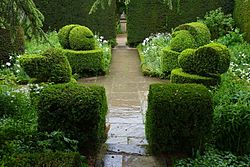Hidcote Manor Garden
| Hidcote Manor Garden | |
|
National Trust | |
|---|---|
 Hidcote Manor Garden | |
| Grid reference: | SP17574296 |
| Location: | 52°5’5"N, 1°44’42"W |
| Information | |
| Website: | Hildcote |
Hidcote Manor Garden is a garden in Gloucestershire, is in the tiny village of Hidcote Bartrim, near Chipping Campden. It is part of the Hidcote Estate on the edge of the Cotswold escarpment overlooking the Vale of Evesham.
The estate is owned by the National Trust and runs up to the Warwickshire border on the east. The garden is a visitor attraction opened to the public.
The garden was created by Lawrence Johnston and is one of the best-known and most influential Arts and Crafts gardens in Britain, with its linked "rooms" of hedges, rare trees, shrubs and herbaceous borders.
Close by is another ornate garden, Kiftsgate Court Gardens.
History
Lawrence Johnston and his mother, Mrs Gertrude Winthrop, who were Americans, settled in Britain about 1900. Lawrence immediately became a British subject and fought in the British army during the Boer War. In 1907, Mrs Winthrop purchased the Hidcote Manor Estate. It was situated in a part of Britain with strong connections to the then-burgeoning Arts and Crafts movement and an Anglicized American artistic expatriate community centred nearby at Broadway, Worcestershire.
Johnston soon became interested in turning the fields around the house into a garden. By 1910 he had begun to lay out the key features of the garden, and by the 1920s he had twelve full-time gardeners working for him.
After the Second World War, Johnston spent most of his time at Jardin Serre de la Madone, his garden in the south of France; and in 1947 he gave Hidcote to the National Trust.
The style of the garden has been widely imitated. In 2007 a temporary garden designed by Chris Beardshaw that drew inspiration from Johnson's Hidcote was constructed at the Chelsea Flower Show in London.
Character of Hidcote Garden
 |
 |
 |
 |
Lawrence Johnston was influenced in creating his garden at Hidcote by the work of Alfred Parsons and Gertrude Jekyll, who were designing gardens of hardy plants contained within sequences of outdoor "rooms". The theme was in the air: Vita Sackville-West and Harold Nicolson's Sissinghurst Castle Garden was laid out as a sequence of such spaces, without, it seems, direct connection with the reclusive and shy Major Johnston. Hidcote's outdoor "rooms" have various characters and themes, achieved by the use of box hedges, hornbeam and yew, and stone walls. These rooms, such as the 'White Garden' and 'Fuchsia Garden' are linked, some by vistas, and furnished with topiaries. Some have ponds and fountains, and all are planted with flowers in bedding schemes. They surround the 17th century manor house, and there are a number of outhouses and a kitchen garden.
Johnston's care in selecting the best plants is reflected in the narrow-leaved lavender, Lavandula angustifolia 'Hidcote', in the Penstemon 'Hidcote Pink' and in the hybrid Hypericum 'Hidcote Gold', acclaimed as the finest hardy St John's Wort, Alice Coats records.[1]
See also
Outside links
| ("Wikimedia Commons" has material about Hidcote Manor Garden) |
- Hidcote: information at the National Trust
- Pictures of Hidcote Manor Garden and the area on Geograph.co.uk
- Hidcote Manor on 'Topiary in the United Kingdom'
References
- ↑ Coats, Garden Shrubs and Their Histories (1964) 1992, s.v. 'Hypericum'
- Clarke, E.: 'Hidcote: the making of a garden' (2009)
- Pearson, G. S.; Pavord, Anna: 'Hidcote: the garden and Lawrence Johnston' (National Trust, 2009)
- Sackville-West, Vita: 'Hidcote Manor Garden: Hidcote Bartrim' (National Trust/Country Life, 1960)
- Whitsey, F.: 'The Garden at Hidcote' (2011)